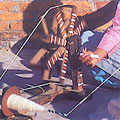In Nepal, spinning of woollen yarn is a women-dominated, home-based craft. Associated closely with the growth of the carpet industry, it received an enormous boost from the waves of Tibetan migration into Nepal, for woollen yarn is eventually used for weaving carpets. Wool spinning is a piece-rate job, with the payment made for every kilogram of the finished product.
PROCESS & TECHNIQUE
The wool, shaped into loose rolls (rolags), is spun on a hand-spindle or a hand-turned spinning-wheel (chakra). The hand-spindles vary in length, the average being about 30 cm, and also in weight, which depends on the type of yarn to be spun. The finest thread is spun on the lightest-weight spindle.
In the spinning process a length of twisted yarn is attached to the spindle tip; the remaining part of the bunch of fibres (rolag) is held by the spinner in one hand, whilst she turns the handle with the other. As she moves her hand with the fibres away from the spindle and releases fibres, wound on to the spindle as the spinner reverses the wheel just a little. She thus continues to draw out and wind on the fibres, controlling the twist by the number of turns she gives to the wheel and the direction of the twist (s or z), by turning the wheel either to the right or the left: the more common is the z twist.
LOCATION
Kathmandu city, Lalitpur, and Bhaktapur have the largest concentration of wool spinners. As this is a good income generation activity it is a popular women’s activity once the household chores are over.
Gallery
YOUR VIEWS
PRACTITIONERS: INDIA
Access 70,000+ practitioners in 2500+ crafts across India.
BIBLIOGRAPHY
10,000+ listings on arts, crafts, design, heritage, culture etc.
GLOSSARY
Rich and often unfamiliar vocabulary of crafts and textiles.
SHOP at India InCH
Needs to be written.






